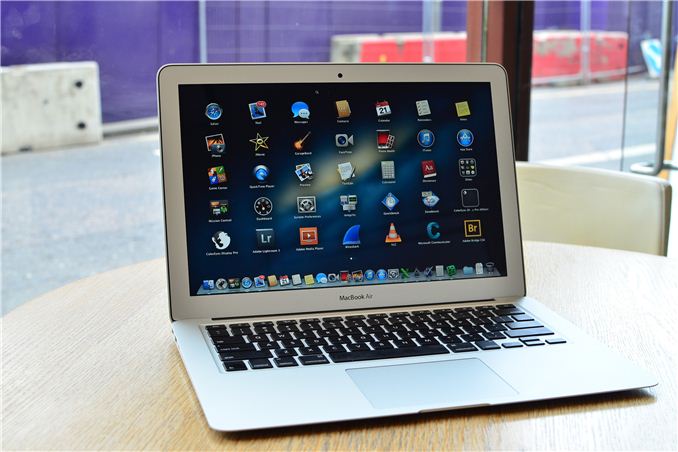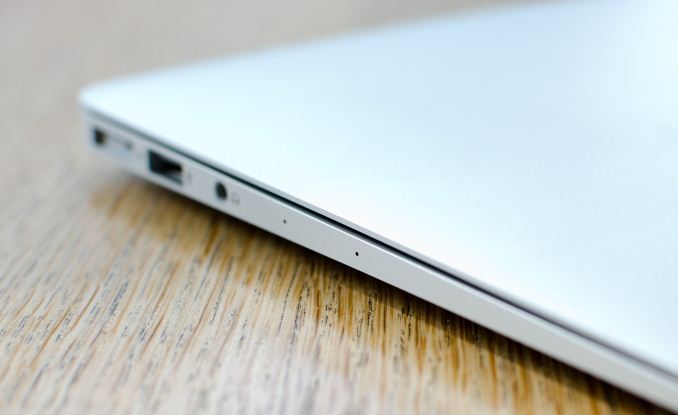The 2013 MacBook Air Review (13-inch)
by Anand Lal Shimpi on June 24, 2013 12:01 AM EST
Things didn’t go exactly as I’d expected at WWDC. I spent the week before the show at Computex, talking to PC OEMs, who had all just launched their Haswell ULT based Ultrabooks. With a couple of exceptions however, the bulk of Haswell ULT systems weren’t scheduled to ship until later this year. Even the Acer S7 I snagged while in Taipei was still a pre-production unit, with final hardware due out in the next month. Based on what I saw in Taiwan, and Intel having seeded me an Iris Pro machine the week before, I assumed that the MacBook Pro with Retina Display is what would get the Haswell treatment first. Obviously, that didn’t happen.
In hindsight, the move makes sense. Apple will sell far more MacBook Airs than rMBPs. The Apple/Intel relationship is looking very healthy these days, so it’s also not surprising that it would have supply and early enough access to Haswell ULT to launch the MBAs at WWDC with almost immediate availability. The Haswell ULT shift didn’t require a new chassis for Apple, which meant a less complex development process.
From the outside, the new MacBook Air looks nearly identical to its predecessor. There's a second mic opening on the left side of the machine now, but otherwise you'd be hard pressed to tell this year's model apart from the previous generation. Internally, nearly everything has changed.
The battery is higher capacity, with no increase in weight. Making better use of that larger battery is Intel's new Haswell ULT silicon. Since we're talking about a ULT part, the PCH moves from the motherboard to the CPU package - creating an emptier motherboard than we've seen in previous years:
The 2013 13-inch MacBook Air Motherboard, Courtesy iFixit
It's clear to me that the MBA is due for a more significant redesign, but this is not the year for that.
Alongside Haswell comes a brand new PCIe SSD, 802.11ac support and LPDDR3 memory. All at a price equal to, if not less than last year's models:
| 2013 MacBook Air Lineup | ||||||
| 11.6-inch | 11.6-inch (high-end) | 13.3-inch | 13.3-inch (high-end) | |||
| Dimensions |
H: 0.11-0.68" (0.3-1.7cm)
W: 11.8" (30cm) D: 7.56" (19.2cm) |
H: 0.11-0.68" (0.3-1.7cm)
W: 12.8" (32.5cm) D: 8.94" (22.7cm) |
||||
| Weight | 2.38 lbs (1.08kg) | 2.96 lbs (1.35kg) | ||||
| CPU | 1.3GHz dual-core Core i5 | 1.3GHz dual-core Core i5 | ||||
| GPU | Intel HD 5000 | |||||
| RAM | 4GB LPDDR3-1600 | |||||
| SSD | 128GB PCIe SSD | 256GB PCIe SSD | 128GB PCIe SSD | 256GB PCIe SSD | ||
| Display Resolution | 1366 x 768 | 1440 x 900 | ||||
| Ports | Thunderbolt, 2x USB 3.0, headphone jack | Thunderbolt, 2x USB 3.0, SD card slot, headphone jack | ||||
| Networking | 2x2:2 802.11ac | 2x2:2 802.11ac | ||||
| Battery | 38 Wh | 54 Wh | ||||
| Price | $999 | $1199 | $1099 | $1299 | ||
We've been over the MacBook Air chassis thoroughly in the past so I won't go through it again here. Build quality remains excellent. The clickpad and backlit keyboard never give me any troubles either. It's sad that we're still having clickpad issues elsewhere in ultraportables but this is one area where Apple's vertically integrated advantage is apparent (as is the company's willingness to spend a little extra on even the little details).
The only thing that hasn't changed, that perhaps should have is the display. The MacBook Air retains the same 1366 x 768/1440 x 900 panels from last year, while much of the competition has moved to at least 1080p IPS in the 13.3-inch form factor. This year at Computex we saw a number of systems move to 2560 x 1440 13.3-inch panels, at least as an option, however I'm expecting those systems to be priced more in line with the 13-inch rMBP rather than the MacBook Air. Admittedly, I don't know the right solution here.Ultra high resolution panels drive cost and power consumption up, the latter which can be offset by going to a larger battery - but then you have a 13-inch rMBP. Perhaps the right move for the MacBook Air would be for Apple to move to IPS panels at least? Or maybe we see a merger of the 13-inch MBA/rMBP, and something new entirely replace the 11-inch model.












233 Comments
View All Comments
darwinosx - Monday, June 24, 2013 - link
Another peson who didn't read the article and knows nothing about Macs.watersb - Monday, June 24, 2013 - link
Excellent review!If only it were available with RAM...
darwinosx - Monday, June 24, 2013 - link
If only you took tow seconds to find out you can order it with 8 GB of ram.appliance5000 - Friday, December 20, 2013 - link
It's available with 8gb ram - but here's the rub: If you have the 512gb ssd coupled with the fact that it's mounted on the pcie bus, your page ins and outs are about as fast as memory - or seemingly so. It's a very fast machine - I've tested it stitching multi gb panos and editing multi gb layered files in CS6 and it just rips.FrozenDarkness - Monday, June 24, 2013 - link
I think people get retina confused with higher resolution computers. Couple things, your windows computer? DPI up scaling sucks too much to truly run retina. Know that retina on a 13 MBP actually runs at a resolution of 1280x800 to be truly "retina" or else you're just up-scaling then down-scaling and burning your graphics card in the process. So in a sense, it's not truly higher resolution in terms of workspace, just in terms of beauty to behold. This also means a MBA retina would have to be a different, higher resolution panel, than the one used in the 13" MBP and at that point, what is the point of the MBP? I think you're more likely to see the MBP become more lik the MBA in size than vice versa.Also, panel lottery sucks, let's not act like apple is the only manufacturer who has a panel lottery or that samsung are only in "review" units.
A5 - Monday, June 24, 2013 - link
Windows 8.1 is supposed to fix the DPI scaling in Windows. Win8 is already significantly better than 7.Beyond that, sharper pixels even without an increased workspace is still a good thing. I think the rMBPs have a mode that does both, anyway.
JarJarThomas - Tuesday, June 25, 2013 - link
Windows 8.1 can't fix the dpi scaling in windows cause the problem is that most desktop applications can't scale well.Fixing dpi scaling with win8 would be similar to the solution apple does for non retine enabled grafics, internally upscale it.
But that would not work with the way the windows grafic stack works and the applications are dependent on this.
So scaling will ONLY be better for modern ui apps, not for desktop apps.
And therefore it will suck
akdj - Wednesday, June 26, 2013 - link
'Desktop applications can't scale well' because and ONLY because of the underlying OS. It's up to the operating systems architecture to provide third party scaling options/abilities. As we've seen with the rMBP....in less than a year, literally hundreds of apps....from small developers ala Pixelmator to the monsters...AKA, Adobe....have updated their 'code' for HiDPI displays. As has Apple with their software....and Windows with their native apps. Look at the Surface Pro for instance. Anything other than native Windows programming is a PITA. Windows 8.1 absolutely can help...regardless of how the graphic stack is set up....it's that low level coding that Windows needs to get creative with. Especially with dozens of OEMs, screen sizes and ratios....it will absolutely fall into Windows hands to provide decent scaling options and APIs for developers. High Rez monitors aren't going anywhere. 4k was all the rage at CES this year....and $7,000 Sony 4k TVs are already at Best Buys.OSx meanwhile has done an excellent job with pixel doubling trickery for text....while allowing developers the ability to natively use every pixel available 'in app' when drawing, editing video or stills....et al.
That said, and as a rMBP and 11" Air owner, I can honestly say the Air's resolution doesn't bug me in the least. It's a 2011 core i7 and I use it daily....right along side my 15" rMBP...which is the best computer I've ever purchased. Almost a full year with it and it still brings a smile to my face. I started my computer life @ 14 with an Apple IIe in '85. I remember being jealous when my buddy got the 'color' screen for his IIc...while I continued to slave away on a green monochrome screen. Lol....I suppose its where we come from, our ages....and therefore, appreciation for higher resolution vs decent resolution (11" Air) more than adequate and a helluva lot better than other choices on the market. Dunno
Bkord123 - Tuesday, June 25, 2013 - link
I do not claim to know a ton about computers, and I'll be honest, half of this review looks like it's written in Latin to me. However, regarding the comment that Windows 8 is better than 7, didn't I read several headlines that Windows 8 is more or less responsible for a massive decline in PC sales?TheinsanegamerN - Sunday, June 30, 2013 - link
the main reason pc sales are declining is a mix of a poor economy and computers lasting longer. machines reached the point of being fast enough for consumers five or six years ago. most consumers dont run out to get the newest thing in laptops, they wait until their current one breaks, which is more pronounced when jobs are not certain and raises are nonexistent. they were declining before windows 8 made it to market, though windows 8 isnt helping at all.